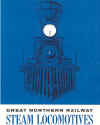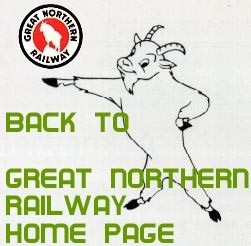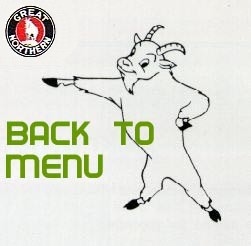|


| | Great Northern Railway - STEAM LOCOMOTIVES
 
NOTE:
CLICK HERE
for current information on remaining GN steam locomotives on display.
The wonderful, colorful age of steam came to a quiet end on Great Northern in the Spring of 1958, when the railway officially retired the surviving few of a once great fleet of steam locomotives. Actually, the "iron horse" performed its final service on GN lines in August, 1957. Thirty-six engines remaining on standby through the winter were never fired again.
The span of the steam era on the "Big G" was 96 years, beginning with the maiden run of the diminutive William Crooks (see below) in 1862 and reaching its apex in 1926, when Great Northern acquired one of the first diesel-electric locomotives in the nation. Meanwhile, however, the railway's roster of steam locomotives already had begun to dwindle from an all-time peak of 1,428 in 1920, as larger and more efficient engines of this type were placed in service.
Nostalgia for its incomparable sights and sounds will pass, but interest in the steam locomotive shows no sign of waning. In fact, it is the ever-growing demand for pictures of Great Northern steam power that prompted the publication of this photo brochure. Shown here are representative locomotives from all 19 major classes which at one time or another appeared on Great Northern's steam roster.

THE WILLIAM CROOKS
The first steam locomotive in the Northwest, a balloon-stack American built by Smith & Jackson at Paterson, NJ, arrived in St. Paul in 1861 -- on a Mississippi River steamboat. It wasn't until the following June 28 that the little William Crooks chuffed out of St. Paul on its initial passenger run to the village of St. Anthony, now Minneapolis, signalizing the completion of the first 10 miles of railroad in Minnesota. The railroad was the St. Paul & Pacific, Great Northern's original predecessor line, and locomotive No. 1 carried the name of its chief engineer, Colonel William Crooks. A century later, on June 28, 1962, Great Northern fittingly commemorated its Centennial of service by presenting the William Crooks to the Minnesota Historical Society. The famous pioneer locomotive can be seen on permanent display in the St. Paul Union Depot. This classic 4-4-0, with tender, weighs 40 tons. Overall length is 51 feet. Diameter of driving wheels: 63 inches.

CLASS A * 6-WHEEL SWITCHER * 0-6-0
Representing this class is No. 27, an A-9 with slide valves. Laird crossheads and Stephenson valve gear. Note the unusual driving wheel spacing and slope-backed tender with arch-bar trucks. Rogers built the first of GN's 0-6-0 yard goats in 1879, and hundreds of the breed from various builders were in use for the next 70 years. Small driving wheels provided high rail adhesion at limited speed, a desirable combination for yard work. Because of their small grate area, many of these locomotives burned coal and were hand-fired to operate on 160 pounds of saturated steam.

CLASS B * AMERICAN * 4-4-0
The 4-4-0 pictured here is a B-19, built by Brooks in 1882. Altogether, Great Northern operated 21 sub-classes of the popular American or Standard type locomotive, which was used for switching as well as for freight and passenger service in earlier years. Its 63-inch drivers provided moderate speed combined with reasonably efficient tractive effort. Note, in the photo of engine No. 186, the four-bar crosshead guides, the roll bell, the chime whistle atop the steam dome, and the road engine pilot. Contrast with photo of the William Crooks, an earlier generation American.

CLASS C * 8-WHEEL SWITCHER * 0-8-0
No. 818, a C-1, is representative of Great Northern's heaviest class of steam switcher. It had 19-inch piston valves, Walschaert valve gear, a Belpaire firebox and was oil-fired. The cab was bay window-equipped for winter service. Driving wheels were 55 inches in diameter, and 250 pounds of superheated steam drove the 26 x 28-inch cylinders. The reverse gear was of the Ragonnet type. GN's 0-8-0 switchers were purchased new from Baldwin in 1918. No. 818 was one of the last of these durable engines to be written off when steam operation was terminated on the GN in 1958.

CLASS D * MOGUL * 2-6-0
This trim 2-6-0, a Brooks-built D-5, carried a St. Paul, Minneapolis & Manitoba Railway number when it was delivered in 1896, although Great Northern already had taken over the Manitoba properties. No. 371 became No. 450 in 1899. Note the oil headlight, the single-stage air pump, hand reverse gear and square counterbalances on the driving wheels. The link and pin couplers, spoked pilot truck wheels and wooden cab and pilot were typical of the era. With its Laird crossheads and clean lines, this was a light freight engine of which to be proud in the "Gay Nineties."

CLASS E * 10-WHEEL * 4-6-0
Heavier trains and the demand for greater speed brought the high-stepping 10 wheeler into service. No. 1024, an E-14, was built by Baldwin in 1909 as a dual-purpose freight and passenger engine. Weighing 100 tons, it had 73-inch drivers and operated on 200 pounds of superheated steam. The hand reverse, alligator crossheads and Walschaert valve gear were typical of the period. Higher tender capacities for both coal and water led to development of cast steel trucks of the equalizer type. Many of these soundly-designed 4-6-0's later were rebuilt to Pacific type locomotives.

CLASS F * CONSOLIDATION * 2-8-0
A contemporary of the 10-wheel and a real work horse on the Great Northern was the 2-8-0 Consolidation. No. 1130, pictured here, was built by Cooke in 1901 and was classed by the GN as an F-7. Note the Stephenson valve gear, alligator crossheads and bay window on the cab. The tender carried 8,000 gallons of water and 19 tons of coal on arch-bar trucks. Working steam pressure was 165 pounds, superheated. The engine was equipped with power reverse gear. Ten of these inside admission engines were constructed in the F-7 class and numbered 1130 to 1139.

CLASS G * 12-WHEEL * 4-8-0
Brooks and Rogers built about 105 of these 4-8-0 engines for Great Northern and its predecessor lines between 1891 and 1900. The builder's photo of Montana Central engine No. 100, a G-5 was made in 1899, the year before it became No. 800 on GN's roster. Experiments with cylinder volumes varied the diameter from 19 to 25 1/4 inches, but all G class engines had 32-inch stroke. Weight varied between 78 and 106 tons in the five sub-classes. This was a simple engine, using inside steam admission, and had piston valves and Stephenson valve gear.

CLASS H * PACIFIC * 4-6-2
In 1926-27, Great Northern constructed a number of 4-6-2's from engines which originally were E-14 10-wheelers built by Baldwin in 1906. Boilers were lengthened by adding a combustion chamber, the firebox was widened and a Delta trailing truck applied. These redesigned locomotives, including No. 1369 (pictured here), joined GN's H-5 class. The handsome Pacific served Great Northern well for many years, powering such name trains as the Gopher, Alexandrian and, occasionally, the Oriental Limited. In later years these engines acquired Vanderbilt-type tenders, whose 12,000 gallon water and 5,800-gallon oil capacity permitted extended runs.

CLASS J * PRAIRIE * 2-6-2
As indicated by the name, Great Northern's Prairie type (2-6-2) locomotives were designed for fast freight service on more level districts. No. 1520, a J-1, exemplifies the class, built by Baldwin in 1906-07. These engines had 69-inch driving wheels and Belpaire firebox boilers. Each engine weighed some 105 tons and exerted about 33,000 pounds of tractive force. In 1921 a program was instituted to convert the Prairies into Class H-6 Pacific type locomotives, but it was well into the 1930's before the 150 engines in the J class had been modified or scrapped.

CLASS K * ATLANTIC * 4-4-2
Ten class K-1 Atlantics (1700-1709) were built by Baldwin in 1906 to provide Great Northern with a light, fast passenger locomotive. The 4-4-2's originally were constructed as balanced compounds, having 15/25 x 26-inch cylinders, 73-inch driving wheels and operating on 200 pounds of saturated steam. Each engine weighed approximately 104 tons. Stephenson valve gear operated the piston valves. Tenders carried 8,000 gallons of water and 13 tons of coal. In later years these engines were made simple (21 x 26-inch cylinders) and superheaters were applied. As late as 1925, the K-1 powered the Oriental Limited over level districts.

CLASS L * MALLET-ARTICULATED * 2-6-6-2
Great Northern's L class (2-6-6-2) locomotives, built by Baldwin in 1906-07, were true Mallets. No. 1810, shown here, was an L-2 of 1907 vintage. These engines had 20/31 x 30-inch cylinders and used 200 pounds of saturated steam (superheaters later were applied to 12 of the original 67 engines). They boasted slide valves and Walschaert valve gear, and weighed 144 tons. The calculated adhesion factor was 4.78 as a measure against wheel slippage. Between 1922 and 1925 the L class engines were converted in the railway's shops to O-5 and O-6 class Mikados (2-8-2 wheel arrangement).

CLASS M * MALLET-ARTICULATED * 2-6-8-0
Another true Mallet type as originally constructed by Baldwin in 1910 was Great Northern's M class 2-6-8-0, a compound with 23/35 x 32-inch cylinders. In 1926-27 these M-1 engines were rebuilt by GN as simple articulated M-2's, having 22/23 1/2 x 32-inch cylinders. Weight was approximately 201 tons and drivers were of 55-inch diameter. (An example is No. 1973, shown here.) The M-2 had a relatively short life, for these engines were destined to be rebuilt again by the GN in 1929-31 as O-7's (2-8-2). Finally, between 1944-46, most of the O-7's were converted to O-8's.

CLASS N * MALLET-ARTICULATED * 2-8-8-0
The N class (2-8-8-0) engines originated with Baldwin in 1912, and were Mallet-type (compound) having 28/42 x 32-inch cylinders. They operated on 210 pounds of superheated steam and weighed 225 tons. During 1925-27 the original N-1's, 25 in all, were made into simple articulated engines, modernized and reclassified as N-2's (see photo of No. 2000). In 1940-41 new nickel steel boilers were applied, along with roller bearings and other modern features. Operating steam power was upped to 265 pounds, cylinders were 22/22 x 32-inches and weight of the engine was increased to 286 tons.

CLASS O * MIKADO * 2-8-2
The popular Mikado (2-8-2) was best exemplified on Great Northern by the celebrated O-8. The first three engines in this sub-class (3397-3399) were GN-built in 1932, and were the only locomotives constructed in the U.S. that year for domestic service. The O-8 was not only the heaviest Mikado type ever built, but the heaviest on axle of any steam locomotive, aggregating 81,250 pounds per axle. Originally designed steam pressure was 280 pounds, but this was later reduced to 250 pounds. Twenty-two rebuilt O-7's joined the O-8 class in 1944-46.

CLASS P * MOUNTAIN * 4-8-2
The long-limbed, racy locomotives numbered from 2500 to 2527 on the GN were classed as P-2's, and were purchased from Baldwin in 1923 to speed up service on the crack Oriental Limited. The operation was so successful that it led to the inauguration, in 1929, of the first of the luxury Empire Builders. The P-2's then performed distinguished service powering the Fast Mail and the
renowned Silk Extras. Note that this 4-8-2 was one of the few Great Northern classes after the turn of the century not to be equipped with the Belpaire firebox.

CLASS Q * SANTA FE * 2-10-2
Designed for heavy freight service, the 2-10-2 Santa Fe was known as a class Q engine on the Great Northern. No. 2100, a Q-1, was the first of 30 built for GN by Baldwin in 1923. Not shown in the builder's photo is the Franklin booster engine which was later applied by the railway. The conical boiler with Belpaire firebox and the Vanderbilt tender carrying 15,000 gallons of water and 25 tons of coal were intriguing features. Overall design was simple and clean, and is an excellent representation of heavy freight power of the period.

CLASS R * SIMPLE ARTICULATED * 2-8-8-2
The mountain-shrinking 2-8-8-2 was the all-time giant of Great Northern's steam fleet -- and the largest locomotive in the world when Baldwin built the first of its class. Most of the big R's, however, came from the railway's own shops at Hillyard, Washington, and were the first steam locomotives built in the Pacific Northwest. Heaviest and most powerful of two sub-classes was the R-2, pictured here. Overall length, with tender, was 119 feet, 11 1/4 inches; total weight was nearly 530 tons. Twenty-six of these monsters -- 10 R-1's and 16 R-2's -- were constructed in 1927-28.

CLASS S * NORTHERN * 4-8-4
The powerful and speedy Northern looked every bit the aristocrat that it was during the years of its pre-eminent association with the crack Empire Builder and Oriental Limited trains of the steam era. Baldwin built these 4-8-4's, specifically for this service in 1929-30. In later life they powered GN fast freights on eastern districts, and were roller bearing-equipped in 1945. (No. 2578, shown here, was an S-2.) Mounting of the air pump, bell and headlight on the smokebox front was one of the features that gave this engine its massive appearance.

CLASS Z * 4-CYLINDER ARTICULATED * 4-6-6-4
In 1937 the American Locomotive Company built a number of 4-Cylinder Articulated or Challenger type locomotives of the Northern Pacific Z-6 design for the Spokane, Portland and Seattle Railway. Great Northern acquired two of these 4-6-6-4's in 1939, retaining the Z-6 designation but renumbering them 4000 and 4001. By 1950 both locomotives had been resold. The simple articulated Z-6 weighed 310 tons and was equipped with three Nicholson syphons and a combustion chamber in an effort to increase the heating surfaces. The tender carried 20,000 gallons of water and 6,000 gallons of fuel oil.
GREAT NORTHERN STEAM LOCOMOTIVES ON PERMANENT EXHIBITION
1. No. 1, the William Crooks, can be seen in the main concourse of the St. Paul Union Depot, where it was publicly dedicated on June 28, 1954.
2. No. 1246, a Consolidation (F-8), was presented to the City of Seattle, Washington, on July 18, 1953, and is displayed in Woodland Park.
3. No. 1355, a Pacific (H-5), was dedicated July 14, 1955 at Sioux City, Iowa, where it can be seen at the Municipal Auditorium grounds.
4. No. 1147, a Consolidation (F-8), was presented to the City of Wenatchee, Washington, in dedication ceremonies on June 2, 1956. It is displayed at Wenatchee City Park.
5. No. 3059, a Mikado (O-1), was presented to the City of Williston, North Dakota, on August 2, 1958, and stands in a public park adjacent to the Great Northern depot.
6. No. 2584, a Northern (S-2), is on exhibition adjacent to the Great Northern passenger station at Havre, Montana, where it was dedicated on May 15, 1964.
7. No. 2523, a Mountain (P-2), can be seen at the Kandiyohi County Historical Society Center northeast of Willmar, Minnesota on Highway 71. This last of Great Northern's steam locomotives was presented to the Society in a ceremony on October 17, 1965.
NOTE:
CLICK HERE
for current information on remaining GN steam locomotives on display.
  |

